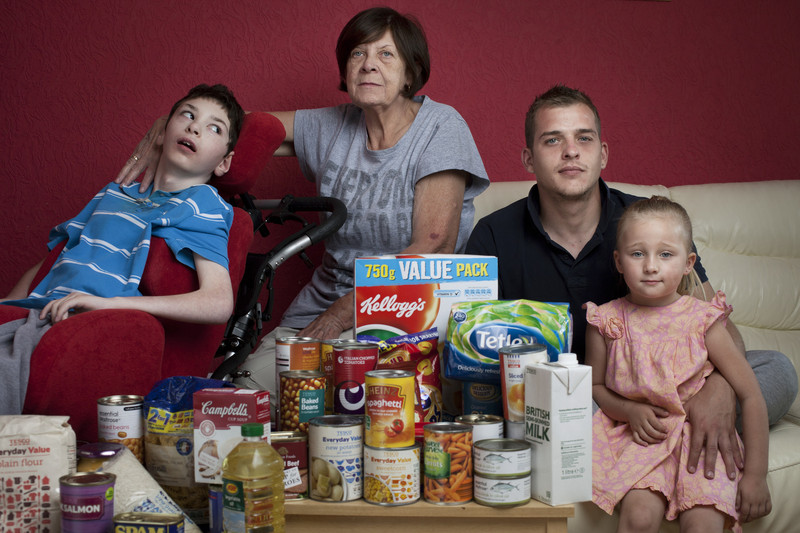7 photos that reveal what families eat in one week
by Anna Kramer, Oxfam America
How much food does your household go through in a week? What are your go-to family meals? And how much do you spend on food? You can get a glimpse of how others answered these questions in Oxfam’s new photo series, which depicts people from around the globe with one week’s food supply for their families.
Building on an idea that originated with 2005′s Hungry Planet: What the World Eats, the new images feel especially timely now, when reports about half of the world’s food going to waste vie for space with news about rising global food prices. According to a recent article accompanying some of the photos in the Independent (UK), “There is deep injustice in the way food is grown and distributed … the world’s poorest people spend 50-90 percent of their income on food, compared with just 10-15 percent in developed countries.”
As you can probably guess, the families’ diets differ depending on where they live. But if if there’s one common thread that links these images, it’s that we all have to eat. We all face challenges and successes when it comes to feeding our families. And we can all help to make the food system fairer for everyone.
So check out seven highlights below. What does your week’s food supply look like? How does your family measure up?
Shahveller, Azerbaijan
Photo: David Levene/Oxfam
Mirza Bakhishov, 47, his wife, Zarkhara, 37, and two sons, Khasay, 18 and Elchin, 15, own a small plot of land where they grow cotton and wheat as well as animal feed. “Our small cattle and poultry [are] everything for us. All our income and livelihood is dependent on them,” said Bakhishov.
Vavuniya, Sri Lanka

Photo: Abir Abdullah/Oxfam
Selvern, 70, far right, and her daughters have been members of Oxfam’s local dairy cooperative for four years. Her youngest daughter Sukitha, second from right, works at the cooperative and is also trained as a vet. Selvern gets up at 5:30 every morning to help her daughters milk their cows; she sends most of the milk to the co-op with Sukitha and uses the remainder to make cream and ghee for the family.
Mecha, Ethiopia

Photo: Tom Pietrasik/Oxfam
A week’s food supply for Wubalem Shiferaw, her husband Tsega, and 4-year-old daughter Rekebki includes flour, vegetable oil, and a paste of spices called berbere. Tsega works as a tailor, while Wubalem follows a long local tradition and supplements her income with honey production. An Oxfam-supported cooperative helped Wubalem make the transition to modern beekeeping methods, which produce greater yields.
Yegeghus, Armenia

Photo: Abbie Trayler-Smith/Panos
The Josephyan family with their weekly food supply, which includes wheat flour, dried split peas, sugar, and cooking oil. The family supplements their diet with eggs laid by their chickens and wild greens from the fields.
London, UK

Photo: Abbie Trayler-Smith/Oxfam
Ian Kerr, 30, with his family and a week’s food supplied by a charity food bank. Ian left his job to become a full-time carer to his disabled son Jay-J, 12. Also pictured are his daughter Lillian, 5, and mother-in-law Linda, 61. Kerr says the family’s favorite food is spaghetti Bolognese, but Lillian says her favorite is Jaffa Cakes.
Kaftarkhana, Tajikistan

Photo: Andy Hall/Oxfam
BiBi-Faiz Miralieba and her family, from left to right: son Siyoushi, 11, niece Gulnoya Shdova, 14, and children Jomakhon, 6, Shodmon, 9, and Jamila,13. Like many women in rural areas of Tajikistan, Miralieba is now the head of her household as her husband has migrated to Russia to find work.
Gutu, Zimbabwe

Photo: Annie Bungeroth/Oxfam
Ipaishe Masvingise and her family with their food for the week, which includes grains and groundnuts as well as fruits like pawpaw and oranges. Masvingise, a farmer, said she sells extra grain from her harvests to pay for school fees and medical costs, and to support members of her extended family who don’t own their own land.
A version of this post originally appeared on Oxfam America's blog, January 23, 2012

